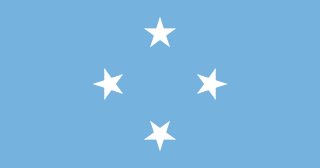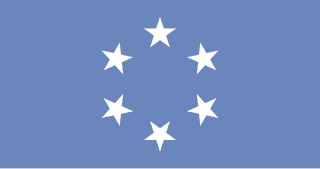
The Federated States of Micronesia, or simply Micronesia, is an island country in Micronesia, a subregion of Oceania. The federation consists of four states—from west to east, Yap, Chuuk, Pohnpei, and Kosrae—that are spread across the western Pacific. Together, the states comprise around 607 islands that cover a longitudinal distance of almost 2,700 km (1,700 mi) just north of the equator. They lie northeast of Indonesia and Papua New Guinea, south of Guam and the Marianas, west of Nauru and the Marshall Islands, east of Palau and the Philippines, about 2,900 km (1,800 mi) north of eastern Australia, 3,400 km (2,100 mi) southeast of Japan, and some 4,000 km (2,485 mi) southwest of the main islands of the Hawaiian Islands.

Geography of the Federated States of Micronesia (FSM), a country located in the western Pacific Ocean, and in the Micronesia cultural and ecological sub-region of Oceania. While its total land area is very small at 702 km2 (271 sq mi), it has the 14th largest exclusive economic zone at 2,996,419 km2 (1,156,924 sq mi).

Micronesia is a subregion of Oceania, consisting of approximately 2,000 small islands in the Northwestern Pacific Ocean. It has a close shared cultural history with three other island regions: Maritime Southeast Asia to the west, Polynesia to the east, and Melanesia to the south—as well as with the wider community of Austronesian peoples.

The Trust Territory of the Pacific Islands (TTPI) was a United Nations trust territory in Micronesia administered by the United States from 1947 to 1994. The Imperial Japanese South Seas Mandate had been seized by the US during the Pacific War, as Japan had administered the territory since the League of Nations gave Japan mandate over the area from Imperial Germany after World War I. However, in the 1930s, Japan left the League of Nations, and then invaded additional lands. During World War II, military control of the islands was disputed, but by the end of the war the islands had come under control of the Allies. The Trust Territory of the Pacific was created to administer the islands as part of the United States, while still under the auspices of the United Nations. Most of the island groups in the territory became independent states, with some degree of ties kept with the United States: the Federated States of Micronesia, Marshall Islands and Palau are today independent states in a Compact of Free Association with the US, while the Northern Mariana Islands remain under US jurisdiction, as an unincorporated territory and commonwealth.

Pohnpei is an island of the Senyavin Islands which are part of the larger Caroline Islands group. It belongs to Pohnpei State, one of the four states in the Federated States of Micronesia (FSM). Major population centers on Pohnpei include Palikir, the FSM's capital, and Kolonia, the capital of Pohnpei State. Pohnpei is the largest island in the FSM, with an area of 334 km2 (129 sq mi), and a highest point of 782 m (2,566 ft), the most populous with 36,832 people, and the most developed single island in the FSM.

Kosrae, formerly known as Kusaie or Strong's Island, is an island and state in the Federated States of Micronesia. It includes the main island of Kosrae and a few nearby islands and islets, the most significant of which is inhabited by 1,500 people.

The flag of the Federated States of Micronesia was adopted on 30 November 1978. The blue field represents the Pacific Ocean. In an echo of U.S. heraldic practice, the stars represent the four federated states: Chuuk, Pohnpei, Kosrae and Yap, arranged like the points of the compass.

The flag of the Trust Territory of the Pacific Islands (TTPI) consisted of a light blue field that contained six white stars centered in a circle pattern. The stars symbolized the six districts of the Trust Territory of the Pacific Islands: the Marianas, the Marshall Islands, Yap, Chuuk, Pohnpei, and Palau. The blue field symbolized freedom and loyalty.

Chuuk State is one of the four states of the Federated States of Micronesia (FSM). It consists of several island groups: Namoneas, Faichuuk, the Hall Islands, Namonuito Atoll, Pattiw, and the Mortlock Islands. Chuuk is by far the FSM's most populous state, with 50,000 inhabitants on 120 square kilometers. Chuuk Lagoon is where most people live. Weno island, in the lagoon, is Chuuk's state capital and the country's biggest city. It may hold a referendum on independence in the near future, although this referendum has been repeatedly postponed.

The State of Yap is one of the four states of the Federated States of Micronesia, located in the westernmost portion of the country. The state borders Palau to the southwest, Guam to the north, and Chuuk State to the east. According to the state's population census carried out in 2020, the total population is 11,577 residing across a total area of 119.54 sq km, though a large majority of the area is water. The only town area in the state, Colonia, serves as the state capital.

The Federated States of Micronesia Football Association or FSMFA is the governing body of football in the Federated States of Micronesia, and of the national team. They are not a member of FIFA or a regional confederation.

The Federated States of Micronesia's National Police is the small national police force of the Federated States of Micronesia and is a division of the FSM Department of Justice.
Micronesian Americans are Americans who are descended from people of the Federated States of Micronesia. According to the 2020 US Census, a total of 21,596 residents self-identified as having origins in the country, which consists of four states. More than half of these residents identified their origin as Chuuk State (12,464) with the rest as follows: 4,918 people from Pohnpei, 2,066 from Yap, and 2,148 people from Kosrae.

Japanese Micronesians, also Nikkei Micronesians or Micronesians of Japanese descent, refers to citizens of the Federated States of Micronesia (FSM) who are of Japanese descent and are members of the Japanese global diaspora known as the Nikkei (日系).

This is a survey of the postage stamps and postal history of the Federated States of Micronesia (FSM).
Education in the Federated States of Micronesia is required for citizens aged 6 to 13, and is important to their economy. The literacy rate for citizens aged 15 to 24 is 98.8%.
The Federated States of Micronesia is a United States Associated State consisting of 4 states across the Western Pacific Ocean. The estimated population in 2015 was 105,216. Formerly the FSM was a part of the Trust Territory of the Pacific Islands (TTPI) but in 1979 formed its own constitutional government. FSM has a written constitution which took effect in 1979 and has been amended only once in 1990. By virtue of membership in the United Nations, the FSM abides by the UN Declaration of Human Rights (UDHR). Key human rights concerns in FSM include judicial delays, government corruption, discrimination against women, domestic violence and child neglect.
Bailey Olter High School, formerly Pohnpei Island Central School (PICS), and Pacific Islands Central School, is a senior high school in Kolonia, Pohnpei Island, Pohnpei State, Federated States of Micronesia. As of 2018 the school, operated by the Pohnpei State Department of Education, has about 1,500 students, making it the state's largest high school. Its service area includes Kolonia, Nett, Sokehs, and U.

The Church of Jesus Christ of Latter-day Saints in the Federated States of Micronesia refers to the Church of Jesus Christ of Latter-day Saints and its members in the Federated States of Micronesia (FSM). The church's first known missionaries arrived on July 5, 1978. As of December 31, 2022, there were 5,966 members in 23 congregations in FSM. The LDS Church has congregations in every state in the FSM.












